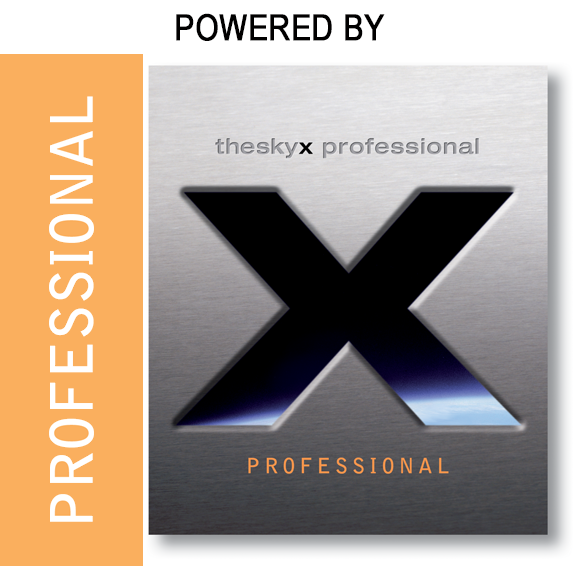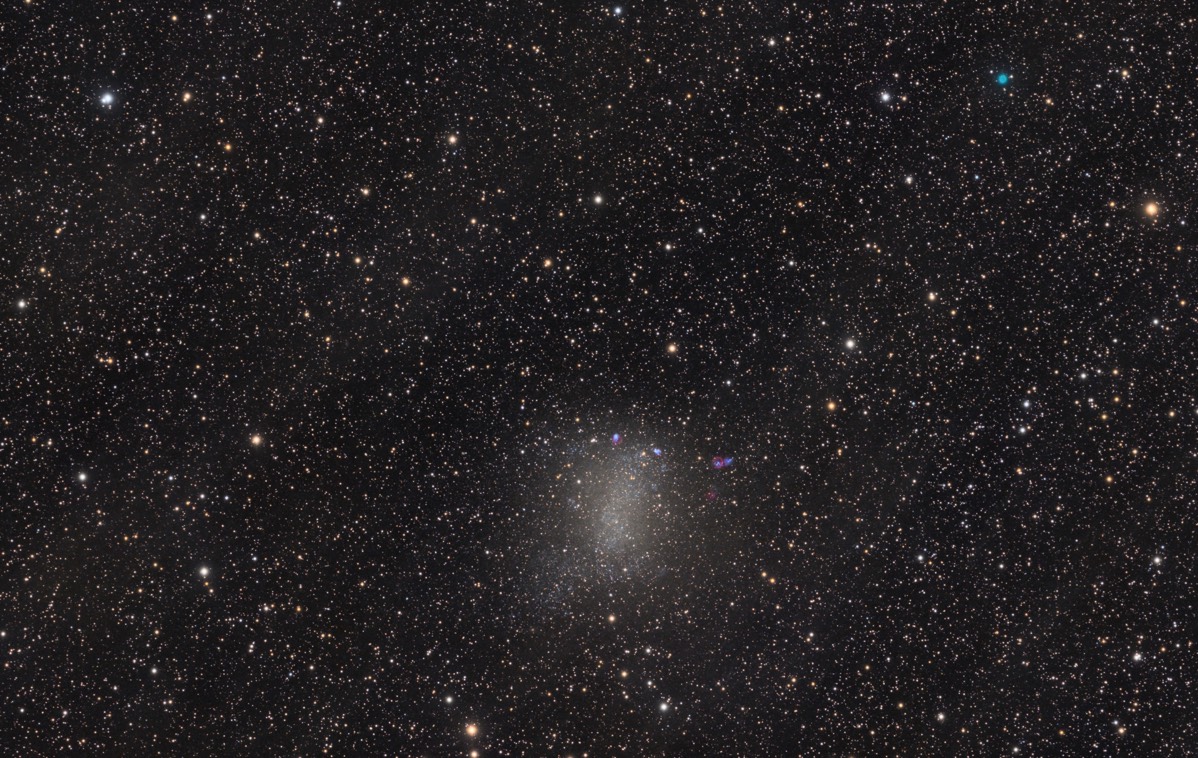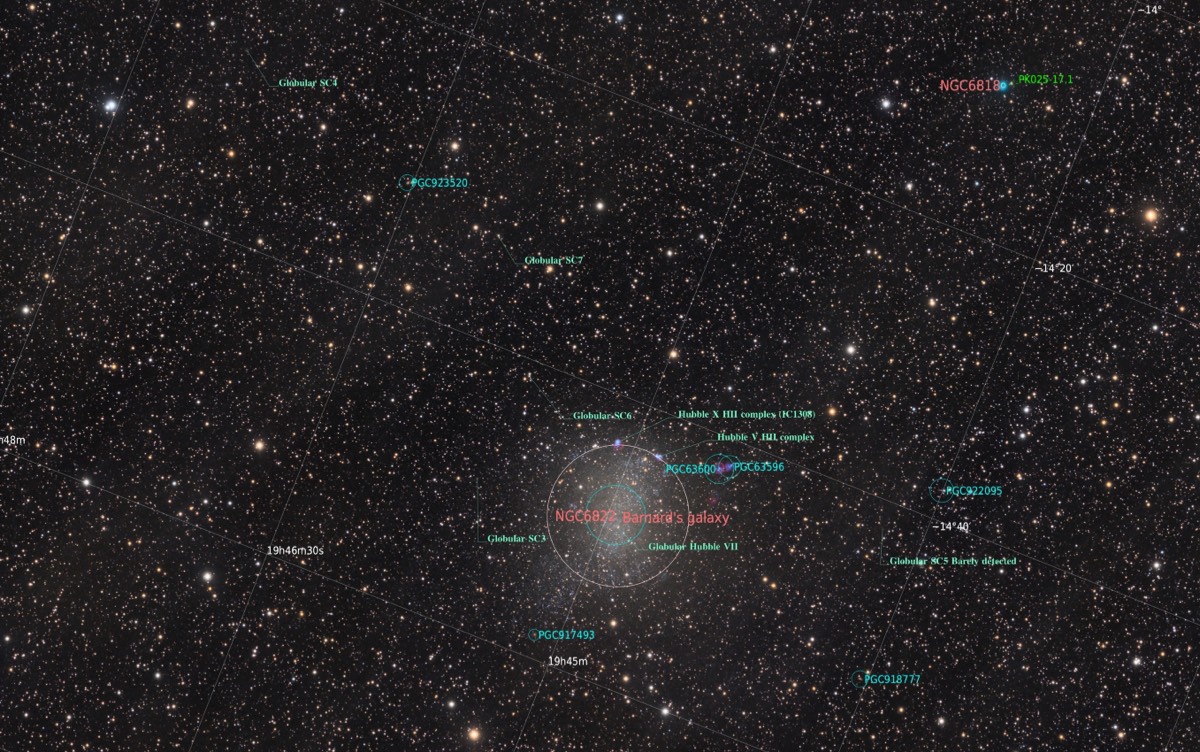NGC6822, Barnard's Galaxy
Published 20 September 2020
Click the image above and below for a full resolution view
About this object
NGC6822, also known as Barnard's Galaxy lies in the constellation at 1.6 million light years distant. NGC 6822 is a barred irregular dwarf galaxy and is part of our local group of galaxy's. It was discovered by E. E. Barnard in 1884 using a small refractor. Within Barnard's Galaxy are several bright reddish HII emission nebula which can be seen in the images above. In the image above the HII region furthest to the NW is known as Hubble 1925 1 (PGC63596 in annotated image) and is often called the Bubble nebula within Barnard's Galaxy. The Ring nebula within Barnards galaxy is right next door to the bubble nebula and looks like a red ring. Its designation is Hubble 1925 III (PGC 63600 in annotated image). Two more bright HII emission regions are named the Hubble V HII complex and Hubble X HII complex (IC1308). A 2015 paper by Veljanoski, et. al. titled "The Globular Cluster System of NGC6822" outlined several globular clusters within the galaxy. All except one were in the field of view and detectable. They are listed and their positions shown on the Annotated image (click on the image for full resolution). There is also a blue/green blob in the upper right of the image. This is the planetary nebula called the "Little Gem Nebula" or NGC 6818. It's a glowing shell of gas ejected from a red giant star late in life. There are few amateur images of it that I could find but a great Hubble telescope shot is available here. It's quite small at 15x20 arc sec in size but looking at the full resolution image you can make out some detail. NGC 6818 was discovered by William Herchel in 1787. There are several faint galaxies throughout the image and listed on the annotated version. Finally, there is some faint dust that can be seen scattered throughout the image which isn't surprising since this is fairly close to the Milky Way in Sagittarius.
The image was shot using 2x2 software binning and the image resolution is 1.28 arc seconds/pixel.
Processing notes: The image was processed with PixInsight. The raw data was calibrated using the WBPP script. Images were blinked to figure out which ones were taken on nights with the best transparency and which ones I had to discard due to clouds. The subframe selector process was used to pick the best luminance image to align the others to and to assign weights to the images. Local normalization was then applied to the images using a stack of several of the best images through each filter. The images from each filter were then stacked with image integration. Mure Denoise was applied to the master LRGB images. The images were saved to disk and then a Super Luminance as created using image integration and the master LRGB images. Noise evaluation was used to determine weights and no rejection was selected. The resulting super luminance was used as the main luminance image in further processing. DBE was applied to each master to remove gradients. A RGB image was made using channel combination. The image was color calibrated using photometric color calibration. Atmospheric blur was compensated for using 50 iterations of deconvolution applied to the super luminance. Both the super luminance and RGB images were stretched using a mask over the small planetary nebula so as not to blow it out and then combined into a LRGB image using the LRGB tool. Several masks were made using the GAME script to process and enhance the nebula within the galaxy. A small preview was made over the small planetary nebula and this preview was brought out as an image. HDR multiscale transform was applied to this small image to bring out some of the internal structure of the small planetary nebula. This image was then inserted back into the main image using Pixel Math. Color saturation was adjusted using appropriate masks and several iterations of curves was used to enhance details and color balance. The image was then cropped down a bit from the full 35mm format and various sizes were saved as jpeg images.
NGC6822, also known as Barnard's Galaxy lies in the constellation at 1.6 million light years distant. NGC 6822 is a barred irregular dwarf galaxy and is part of our local group of galaxy's. It was discovered by E. E. Barnard in 1884 using a small refractor. Within Barnard's Galaxy are several bright reddish HII emission nebula which can be seen in the images above. In the image above the HII region furthest to the NW is known as Hubble 1925 1 (PGC63596 in annotated image) and is often called the Bubble nebula within Barnard's Galaxy. The Ring nebula within Barnards galaxy is right next door to the bubble nebula and looks like a red ring. Its designation is Hubble 1925 III (PGC 63600 in annotated image). Two more bright HII emission regions are named the Hubble V HII complex and Hubble X HII complex (IC1308). A 2015 paper by Veljanoski, et. al. titled "The Globular Cluster System of NGC6822" outlined several globular clusters within the galaxy. All except one were in the field of view and detectable. They are listed and their positions shown on the Annotated image (click on the image for full resolution). There is also a blue/green blob in the upper right of the image. This is the planetary nebula called the "Little Gem Nebula" or NGC 6818. It's a glowing shell of gas ejected from a red giant star late in life. There are few amateur images of it that I could find but a great Hubble telescope shot is available here. It's quite small at 15x20 arc sec in size but looking at the full resolution image you can make out some detail. NGC 6818 was discovered by William Herchel in 1787. There are several faint galaxies throughout the image and listed on the annotated version. Finally, there is some faint dust that can be seen scattered throughout the image which isn't surprising since this is fairly close to the Milky Way in Sagittarius.
The image was shot using 2x2 software binning and the image resolution is 1.28 arc seconds/pixel.
Processing notes: The image was processed with PixInsight. The raw data was calibrated using the WBPP script. Images were blinked to figure out which ones were taken on nights with the best transparency and which ones I had to discard due to clouds. The subframe selector process was used to pick the best luminance image to align the others to and to assign weights to the images. Local normalization was then applied to the images using a stack of several of the best images through each filter. The images from each filter were then stacked with image integration. Mure Denoise was applied to the master LRGB images. The images were saved to disk and then a Super Luminance as created using image integration and the master LRGB images. Noise evaluation was used to determine weights and no rejection was selected. The resulting super luminance was used as the main luminance image in further processing. DBE was applied to each master to remove gradients. A RGB image was made using channel combination. The image was color calibrated using photometric color calibration. Atmospheric blur was compensated for using 50 iterations of deconvolution applied to the super luminance. Both the super luminance and RGB images were stretched using a mask over the small planetary nebula so as not to blow it out and then combined into a LRGB image using the LRGB tool. Several masks were made using the GAME script to process and enhance the nebula within the galaxy. A small preview was made over the small planetary nebula and this preview was brought out as an image. HDR multiscale transform was applied to this small image to bring out some of the internal structure of the small planetary nebula. This image was then inserted back into the main image using Pixel Math. Color saturation was adjusted using appropriate masks and several iterations of curves was used to enhance details and color balance. The image was then cropped down a bit from the full 35mm format and various sizes were saved as jpeg images.
Image Details
- Optics : Stellarvue SVX 152 refractor @f8 1200mm FL
- Mount: Paramount MYT
- Camera: ZWO ASI6200
- Filters: Chroma 50mm LRGB
- Exposure (min): LRGB 200:150:150:140 10.3hrs, 2x2 binning
- Camera/Mount Control: The Sky X, Voyager
- Guiding: StarlightXpress Lodestar X2
- Processing: PixInsight 1.8,
- Location: Stark Bayou Observatory, Ocean Springs, MS
- Sky: Typical SQM 19.6-20.1, Bortle 5, Suburban
- Date: 18 Aug- 10 September 2020








